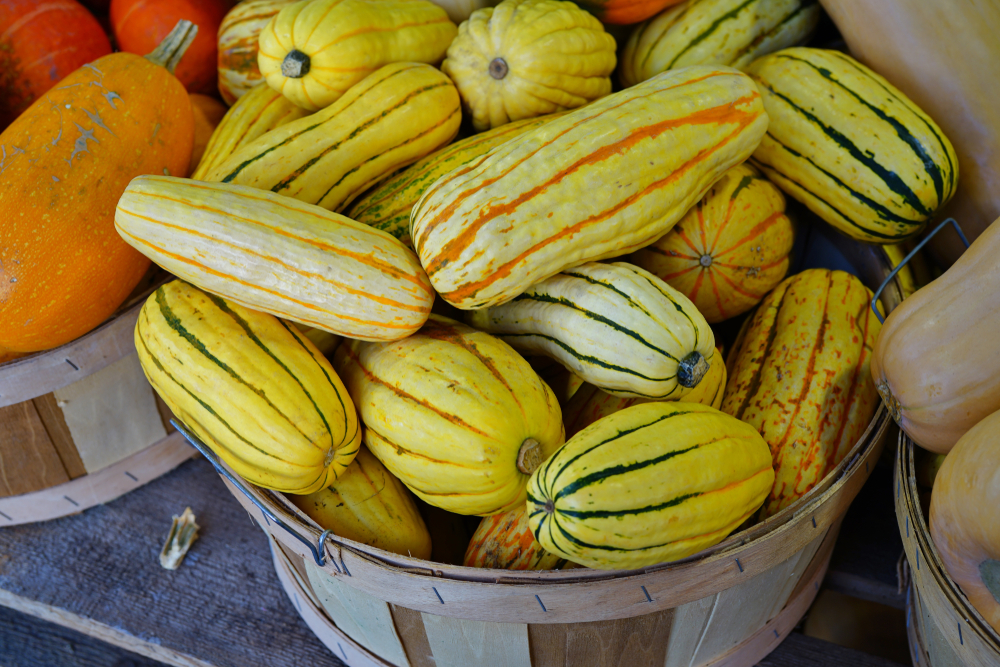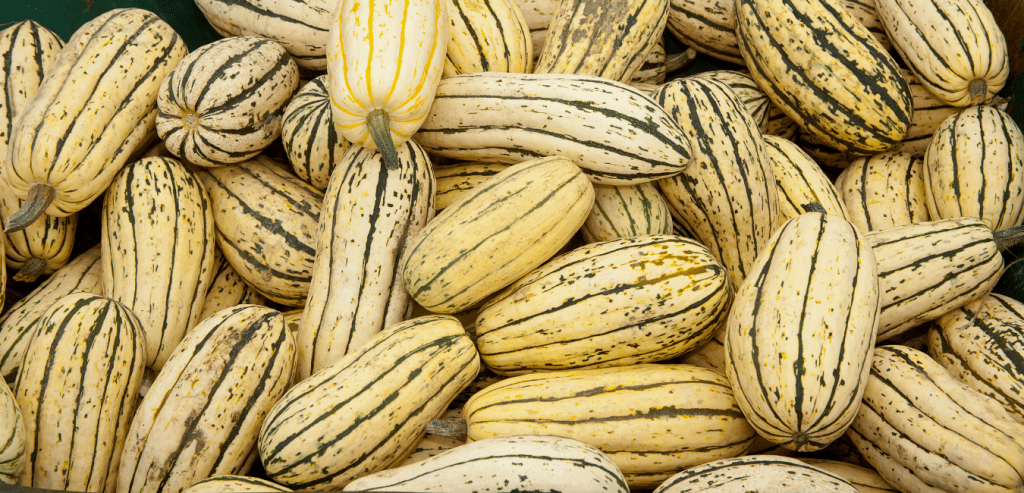

Now, it’s fair to say that there is a great variety of squash out there… but have you ever heard of a delicata squash?
With a unique striped appearance, delicata squash frequently goes unnoticed with many left scratching their heads on what the vegetable actually is.
So what the heck is it? Hold your horses, you’re about to find out.
A delicata squash can be described as something between a butternut squash and a pumpkin and it is seemingly growing in popularity as the go-to squash.
The squash is also known as peanut squash and sweet potato squash. With a beautiful yellow skin and green striped appearance, many wonder whether the thing is edible or just pretty to look at.
You’ll often begin to see delicata squash popping up more during the winter as it is considered to be a winter squash as it is harvested late in the season. However, the squash has soft skin and actually comes from the yellow summer squash and zucchini family also known as the Cucurbita pepo family.


Did you know that delicata squash was introduced in the late 1800s. However, its popularity dropped as the squash became susceptible to disease. Since then the squash has made a remarkable recovery and regained its status of popularity.
Compared to other winter squash such as butternut squash and spaghetti squash, you’ll find more macronutrients of protein and carbohydrates in delicata squash. Delicata squash is nutrient rich packed with a range of vitamins and minerals, particularly vitamins A and C.
The squash is made of carbohydrates. Delicata squash is also rich in healthy fatty acids and rich in antioxidants. Antioxidants help to restore damaged cells. The squash is also rich in potassium which is great for helping promote heart health as it helps to reduce blood pressure.
Delicata squash is low in calories and carries zero cholesterol or saturated fats. This makes it a great choice of food for anyone on a low calorie and fat diet. It also offers great nutritional value with the added advantage of having edible skin. It’s skin offers a great source of soluble and insoluble fiber.
Delicata is a naturally gluten-free food. This a great substitute for any with gluten intolerance as it can be easily incorporated into meals. It can also be used to make pasta as a gluten free alternative or the seeds can be used to make a gluten free snack.
You’ll be pleased to know that delicate squash requires minimal preparation. One of the easiest ways of preparing the squash is to simply cut the squash in half, scoop the seeds out from the middle (set the seeds aside in a bowl for later), and then slice the squash into cubes or rings.
Once it’s all chopped up, you can place the squash onto a baking tray and drizzle a little olive oil and season with salt and pepper or herbs and spices of your choice. Then, place them into a preheated oven until they become soft and caramelized, and voila!
Don’t forget the seeds!
Like pumpkin seeds, delicata seeds can also be roasted into a delicious snack. Remember that bowl of seeds you set aside? Now’s the time to bring them back out…Here’s how to make salted roasted delicata squash seeds:
To make your roasted delicata seeds you’ll need:
Instructions:
Also known as sweet potato squash, delicata squash tastes very similar to sweet potato. It offers the same sweet and buttery flavor and moist texture. However, if you’re a fan of butternut squash, delicata squash also tastes very similar to butternut squash but slightly sweeter and rich in its texture.
Delicata squash is popular for many reasons but one of the most interesting reasons is that it has edible skin. Forget the days of struggling to cut up a pumpkin or peel a butternut squash. With a delicata squash you won’t have to worry about a thing.
If you love the taste of butternut squash and pumpkin but you just can’t be dealing with the hassle of intense preparation… Maybe it’s time to make a change to delicata.
You can tell whether a delicata squash is ripe or not by looking at its stripes. A squash with dark green stripes looks nice but it means that the squash is not quite ripe. However, a squash with orange stripes is ripe and ready to go!
Note – delicata squash should be stored at room temperature in a dark and cool place. In the correct storage, it can last up to 10 days. Once cooked you can store it in a sealed container in the refrigerator for up to 4 days or in the freezer for up to 3 months.
So now you know all about delicata squash, will you be making the switch? If you’re a fan of the rich sweet taste of sweet potato, you’ll love delicata squash. Not only is it delicious, it’s simple to prepare and cook!
Delicata squash is rising in popularity for a reason. Offering great nutritional value this vegetable makes a great addition to many diets including those in a gluten free, low calorie and low fat diet.
Whether you want it roasted, mashed, baked, or you’re just after the seeds, the potential of the things you can do with delicata squash is endless.
We always want to be transparent and honest about our article content. From time to time, we may link to products and services that compensate us for the referral. This does not affect your cost, but it does help us fund future content for this site.
These cheesy beer bread muffins are light, fluffy, and packed with savory flavor! The key…
I am thrilled with how incredibly delicious this Fench Onion Pot Roast turned out! The…
You guys love my marry me recipes and you go crazy over all my mushrooms…
Irish Brown Bread is a delicious twist on classic soda bread, offering a slightly sweet,…
These ground turkey tacos are full of fiesta flavor, all with less fat! Don't let…
Beef and Cabbage soup is filled with seasoned ground beef, cabbage, carrots, celery, kidney beans,…